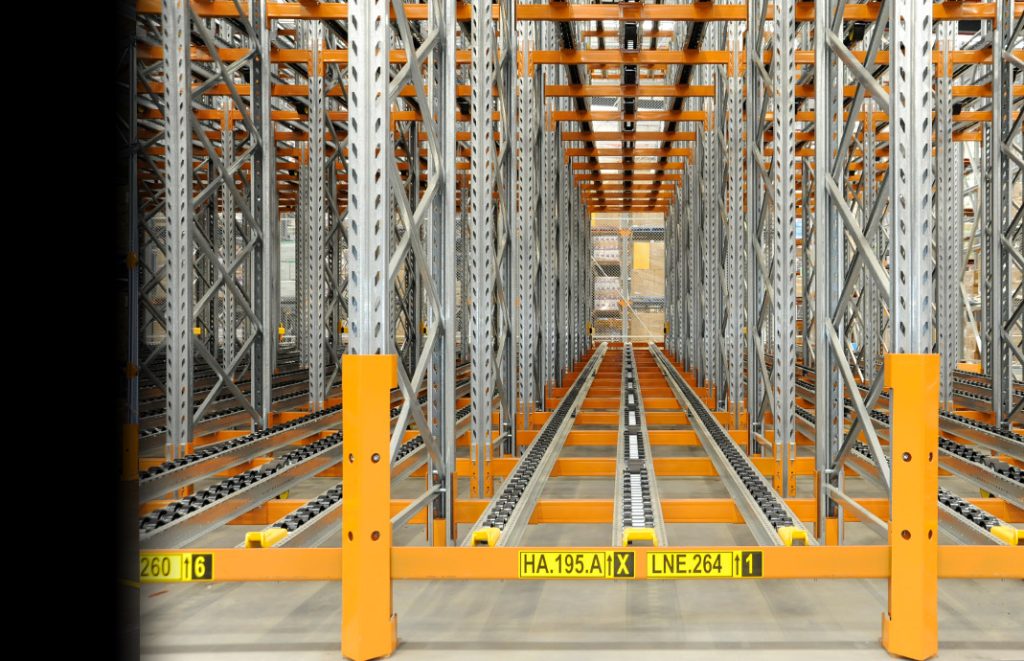There are many different kinds of pallet racking out there, each with a specific use case. What this means is that pallet racking can be designed to suit different situations depending on how the warehouse operates. For example, denser pallet racking often sacrifices selectivity. This may not be a problem though, and it may suit a specific storage situation.

Pallet live storage (PLS) is a type of high density pallet storage that overcomes many of the usual disadvantages of higher density pallet racking by putting pallets on a sliding slope, making them easier to retrieve. Selectivity is still lowered because of the multi-deep storage of pallets, but this can be suitable in many situations.
Pallet live storage is designed to be accessed from both sides. This allows the racking to be loaded at the back of the racking and picked at the front. The racking is built with inclined rollers that automatically allow pallets to slide to the front. This means that pallet live storage is a first in, first out system, which can often make up for the loss of selectivity from higher density pallet storage systems.
Advantages Of Pallet Live Storage
The biggest advantage of pallet live storage is that it’s a first in, first out system. Most multi-deep high density pallet storage systems make it so the pallets that are put in first get stuck behind the pallets that get put in after them, meaning that the pallets in front need to be moved before the pallets at the back can be moved to. This may not be a problem for warehouses with high throughput or if products that aren’t at risk of spoiling are stored, but there are many situations, especially in the storage of food, where high density and first in, first out storage is needed.
The other big advantage to pallet live storage is that it can be safer than other forms of pallet racking. Since the loading and the unloading of pallet live storage happens in different areas, there’s less congestion around the racking and fewer opportunities for accidents.
Pallet live storage is also a fairly fast high density storage system. Since pallets are on rollers, the next pallet automatically slides to the front and is ready for picking. This makes getting the pallet off the racking very fast.
Finally, this is all without even mentioning the high density of pallet live storage. There’s almost no limit to how long rows can be, allowing PLS to be as dense as it needs to be.
Disadvantages Of Pallet Live Storage
Like all kinds of pallet racking, pallet live storage isn’t always the right choice for every situation. It can be great for storage scenarios that leverage its density and first in, first out capabilities, but in other scenarios, different types of pallet racking may be more suitable.
Despite all of its advantages, pallet live storage can often be more expensive than other types of high density pallet racking. This is because PLS is a sophisticated racking solution that operates more complexly than a simple racking system; this is because of the rollers that make it so fast and easy to use. This expense may be worthwhile in situations where it’s warranted, but in other situations, a less expensive pallet racking option may be better.
Going further, while pallet live storage can offer very dense pallet storage, warehouses still need access to both the front and back of the racking, which obviously cuts into storage space. Conversely, racking styles like drive in pallet racking or push back pallet racking don’t need rear access. However, these systems are first in, last out, unlike PLS.
Finally, although there’s almost no limit to how long pallet storage rows can be, the longer they are, the less selectable they become. Here an advantage becomes a disadvantage, but only if the pallet racking is used incorrectly without proper planning.
When To Use Pallet Live Storage
Pallet life storage is the perfect solution for high density storage situations that need first in, first out stock rotation. The most obvious example of this is in food storage.
PLS is also suitable in loading and unloading and cross dock scenarios. In situations like this, pallets can simply be loaded from a truck onto the racking and then unloaded and sorted later on. This takes away some of the disadvantages that PLS has in relation to selectivity, because pallets are simply “waiting in a queue” to be moved elsewhere.
Ultimately though, the exact pallet racking that’s suitable to a business will depend on the exact situation a business is in. Speak to us about your needs, we’re glad to help.




